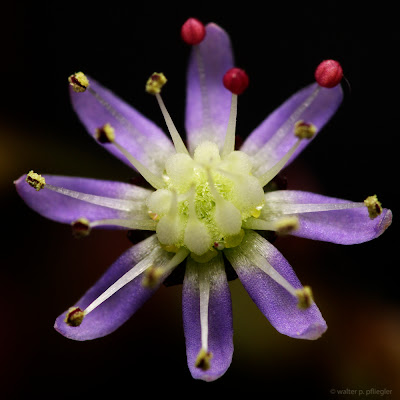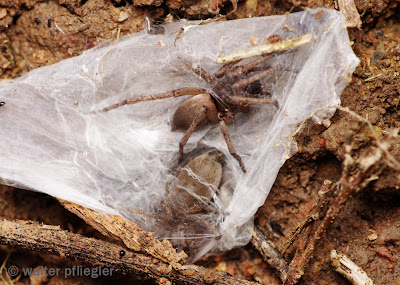In the end of April, we travelled to the beautiful island of Sardinia with a group of arachnology-enthusiasts. We stayed in the province of Sassari in the North-West of the island on the kind invitation of Salvatore Canu and visited numerous places and many different habitats. On the first day, we took a short trip to Monte Forte. The whole Sardinian trip report of the german Spinnen-Forum can be found here.
Ende April sind wir nach die wunderschöne Insel Sardinien mit einer Gruppe von Spinnenenthusiasten gereist. Wir hielten uns auf der lieben Einladung von Salvatore Canu in der Provinz Sassari auf und haben viele verschiedene Örter und verschiedene Habitaten besucht. An dem ersten Tag haben wir eine Kurze Exkursion nach Monte Forte gemacht. Der ganze sardinische Exkursionsbericht der Spinnen-Forum kann man hier finden.
Április végén Szardínia gyönyörű szigetére utaztunk amatőr pókászok lelkes társaságával. Sassari provinciájában tartózkodtunk Salvatore Canu szíves meghívására, és számos helyet és különböző habitatot felkerestünk. Első nap egy rövid kirándulást tettünk a Monte Forte-hoz. A német Spinnen-Forum teljes szardíniai úti beszámolója itt található.
Location/ Ort/ Helyszín: Province of Sassari, Sardinia/ Provinz Sassari, Sardinien/ Sassari provincia, Szardínia. Date/ Datum/ Dátum: 28.04.2013.
Április végén Szardínia gyönyörű szigetére utaztunk amatőr pókászok lelkes társaságával. Sassari provinciájában tartózkodtunk Salvatore Canu szíves meghívására, és számos helyet és különböző habitatot felkerestünk. Első nap egy rövid kirándulást tettünk a Monte Forte-hoz. A német Spinnen-Forum teljes szardíniai úti beszámolója itt található.
Location/ Ort/ Helyszín: Province of Sassari, Sardinia/ Provinz Sassari, Sardinien/ Sassari provincia, Szardínia. Date/ Datum/ Dátum: 28.04.2013.
The Monte Forte:
Der Monte Forte:
A Monte Forte:
Maquis or macchia is very abundant here, with all kinds of stinging shrubs:
Macchie ist hier überall zu finden, mit eine Menge stechenden Sträuchern:
A macchia-vegetáció errefelé nagyon elterjedt, mindenféle szúrós cserjével:
Among the hills and macchia, there are many pastures for grazing animals and small patches of forests.
Zwischen den Hügeln und Macchien gibt es viele Wiesen für Weidevieh und kleine Waldflecke.
A dombok és a macchia között sok legelő található a háziállatok számára, valamint apró erdőfoltok.
In the first part of this post, I only show plants. This is an Asphodelus species:
In diesem ersten Teil des Postes zeige ich nur Pflanzen. Diese ist eine Asphodelus-Art:
A poszt ezen első részében csak növényekről rakok fel képeket. Ez itt egy Asphodelus-faj:
Eine schöne Fetthenneart (Sedum caeruleum):
Egy szép varjúhájfaj (Sedum caeruleum):
A navelwort (Umbilicus sp):
Ein Venusnabel (Umbilicus sp):
Egy vénuszköldök (Umbilicus sp):
Two flowers from the sunflower family:
Zwei Blumen von der Familie der Korbblütler:
Két fészkesvirágú:
A nice Cistus or Rockrose (Cistus sp):
Eine schöne Zistrose (Cistus sp):
Egy szép szuharfaj (Cistus sp):
The plant Cytinus hypocistis ssp hypocystis (Cytinaceae) parasitises Cistus species:
Der Gelbe Zistrosenwürger (Cytinus hypocistis ssp hypocystis, Cytinaceae) schmarotzt auf Zistrosen-Arten:
A sárga szuharalj (Cytinus hypocistis ssp hypocystis, Cytinaceae) szuharokat parazitál:
A toadflax (Cymbalaria sp):
Ein Zimbelkraut (Cymbalaria sp):
Egy pintyő (Cymbalaria sp):
A large spurge species:
Eine große Wolfsmilchart:
Egy nagyméretű kutyatej:
A nice lavender (Lavandula sp):
Ein schönes Lavendel (Lavandula sp):
Egy szép levendula (Lavandula sp):
Small-flowered Lupine (Lupinus micranthus):
Lupinus micranthus, eine Lupine:
Kisvirágú csillagfürt (Lupinus micranthus):
The Butterfly Orchid (Anacamptis papilionacea):
Das Schmetterlings-Knabenkraut (Anacamptis papilionacea):
A pillangós kosbor (Anacamptis papilionacea):
The Heart-flowered Serapias orchid (Serapias cordigera ssp cordigera):
Der Herzförmiger Zungenstendel (Serapias cordigera ssp cordigera):
A szívalakú nyelvorchidea (Serapias cordigera ssp cordigera):
The Small-Flowered Serapias (Serapias parviflora):
Der Kleinblütige Zungenstendel (Serapias parviflora):
A kisvirágú nyelvorchidea (Serapias parviflora):
And a lichen inside another lichen:
Und eine Flechte in einer anderen:
Végül egy zuzmó egy másik zuzmón belül:


Some photos of nice snail species from the town Usini, made at night:
Einige Fotos über Schneckenarten aus der Gemeinde Usini, in der Nacht fotografiert:
Pár fotó szép csigafajokról Usini kommunából, éjszaka fényképezve:


The Decollate Snail (Rumina decollata):
Die Stumpfschnecke (Rumina decollata):
Rumina decollata:
This one is the endemic Tudorella sulcata sulcata:
Diese ist die endemische Tudorella sulcata sulcata:
Ez az endemikus Tudorella sulcata sulcata:

And some photos from more southern areas. A Cteniza sauvagesi trapdoor spider female:
Und einige Fotos von den Südlichen Gebieten. Eine Cteniza sauvagesi Falltürspinne, Weibchen:
És pár fotó a délebbi területekről. Egy Cteniza sauvagesi csapóajtóspók nősténye:

An Euscorpius species, E. sicanus or E. flavicaudis:
Eine Euscorpius-Art, E. sicanus oder E. flavicaudis:
Egy Euscorpius-faj, E. sicanus vagy E. flavicaudis:

The fauna of Sardinia is very interesting: many of the Mediterranean's widespread species are found here, as well as numerous endemic ones unique to the island. The landscape is very diverse with many different habitats, all with a characteristic fauna.
Die Fauna auf Sardinien ist sehr interessant: viele weit verbreitete Arten des Mittelmeerraums sind hier heimisch, sowie zahlreiche endemische, die nur auf der Insel vorkommen. Die Landschaft ist vielfältig mit vielen verschiedenen Lebensräumen, die alle eine charakteristische Fauna haben.
Die Fauna auf Sardinien ist sehr interessant: viele weit verbreitete Arten des Mittelmeerraums sind hier heimisch, sowie zahlreiche endemische, die nur auf der Insel vorkommen. Die Landschaft ist vielfältig mit vielen verschiedenen Lebensräumen, die alle eine charakteristische Fauna haben.
Szardínia állatvilága rendkívül érdekes: sok, a Mediterráneumban előforduló faj mellett számos endemikus, csak a szigeten megtalálható is akad. A táj nagyon sokszínű, számos különböző élettérrel, melyeknek mind megvan a jellemző faunájuk.
Hermann's Tortoise, western subspecies (Testudo hermanni hermanni):
Hermann's Tortoise, western subspecies (Testudo hermanni hermanni):
Griechische Landschildkröte, westliche Unterart (Testudo hermanni hermanni):
Görög teknős nyugati alfaja (Testudo hermanni hermanni):
Görög teknős nyugati alfaja (Testudo hermanni hermanni):
A juvenile Common Wall Gecko (Tarentola mauritanica):
Mauergecko (Tarentola mauritanica):
Fali gekkó (Tarentola mauritanica):
Mauergecko (Tarentola mauritanica):
Fali gekkó (Tarentola mauritanica):
A Metaphalangium propinquum harvestman:
Ein Metaphalangium propinquum Weberknecht:
Egy Metaphalangium propinquum kaszáspók:
Ein Metaphalangium propinquum Weberknecht:
Egy Metaphalangium propinquum kaszáspók:
The male of Philodromus pulchellus, a Philodromid spider:
Männchen von Philodromus pulchellus, ein Vertreter der Laufspinnen:
A Philodromus pulchellus, egy fürgekarolópók hímje:
Männchen von Philodromus pulchellus, ein Vertreter der Laufspinnen:
A Philodromus pulchellus, egy fürgekarolópók hímje:
A lynx spider (Oxyopes sp):
Eine Luchssipnne (Oxyopes sp):
Egy hiúzpók (Oxyopes sp):
The Mediterranean Black Widow (Latrodectus tredecimguttatus):
Die Europäische Schwarze Witwe (Latrodectus tredecimguttatus):
Az európai fekete özvegy (Latrodectus tredecimguttatus):
A pair of Drassodes:
Ein Paar von Drassodes:
Egy Drassodes pár:
This is probably the first photo of Lepthyphantes paoloi, an endemic Linyphiid spider described in 1995:
Dieses ist wahrscheinlich das erste Foto von Lepthyphantes paoloi, eine in 1995 beschriebene endemische Baldachinspinne:
Ez valószínűleg a legelső fotó a Lepthyphantes paoloi fajról, egy 1995-ben leírt endemikus vitorláspókról:
A Carabid beetle with an interesting head (Ditomus sp):
Ein Laufkäfer mit einem interessanten Kopf (Ditomus sp):
Egy futóbogár érdekes fejjel (Ditomus sp):
A nice caterpillar:
Eine schöne Raupe:
Egy szép hernyó:
This insect webspinner (Embioptera), a member of a poorly known insect order:
Dieses Insekt ist ein Tarsenspinner (Embioptera), ein Vertreter einer wenig bekannter Insektenordnung:
Ez a rovar egy szövőlábú (vagy takácsrovar; Embioptera), egy kevésbé ismert rovarrend képviselője:
A juvenile Scolopendra oraniensis:
Ein junges Scolopendra oraniensis:
Egy fiatal Scolopendra oraniensis:
Ein junges Scolopendra oraniensis:
Egy fiatal Scolopendra oraniensis:
A nice woodlouse:
Eine schöne Assel:
Egy szép ászkarák:
Eine schöne Assel:
Egy szép ászkarák:

Some photos of nice snail species from the town Usini, made at night:
Einige Fotos über Schneckenarten aus der Gemeinde Usini, in der Nacht fotografiert:
Pár fotó szép csigafajokról Usini kommunából, éjszaka fényképezve:


The Decollate Snail (Rumina decollata):
Die Stumpfschnecke (Rumina decollata):
Rumina decollata:
This one is the endemic Tudorella sulcata sulcata:
Diese ist die endemische Tudorella sulcata sulcata:
Ez az endemikus Tudorella sulcata sulcata:

And some photos from more southern areas. A Cteniza sauvagesi trapdoor spider female:
Und einige Fotos von den Südlichen Gebieten. Eine Cteniza sauvagesi Falltürspinne, Weibchen:
És pár fotó a délebbi területekről. Egy Cteniza sauvagesi csapóajtóspók nősténye:
A nice big Nemesia cf maculatipes trapdoor spider:
Eine schöne große Nemesia cf maculatipes Falltürspinne:
Egy szép nagy Nemesia cf maculatipes nemezespók:

The large Italian Tube Web Spider (Segestria florentina):
Die sehr große Segestria florentina, eine Fischernetzspinne:
A hatalmas olasz darócpók (Segestria florentina):
An Euscorpius species, E. sicanus or E. flavicaudis:
Eine Euscorpius-Art, E. sicanus oder E. flavicaudis:
Egy Euscorpius-faj, E. sicanus vagy E. flavicaudis:














































Wunderschöne Bilder. Der Venusnabel ist besonders ästhetisch.
ReplyDeleteDanke.
Eveline
Great and I have a swell give: Where To Learn Home Renovation how to renovate a house
ReplyDelete